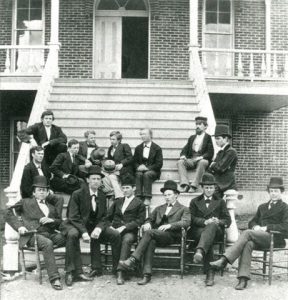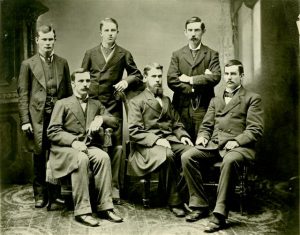Student Life
Campus Living

Students (1878)
The college campus in the 1870s would be unrecognizable today. Neil Farm could be reached by Neil Avenue, or by the Worthington Pike – known to us as High Street – by walking a rutted road on an unlit street, or by waiting for a slow and infrequent street car. In 1875, new pavement was installed on High Street, and a new fleet of horse-drawn streetcars ran along Neil Avenue at seven cents a ride and adhering to a speed limit of six miles an hour. Lights were kerosene, and water was collected in cisterns at ground level and manually pumped into the college building. In the first yearbook, the 1880 Makio, janitor Mike Dillon is referred to as “Professor of Pumping.” Until 1886, all campus sewage drained to a pit just outside University Hall, where, according to Professor William Lazenby
“it not only offended the eye and polluted the atmosphere, but rendered a large tract of land useless by its unregulated overflow.”
The first classes adhered to a rigorous system of demerits, applicable to preparatory as well as college students. Absence from class or drill docked four points, poor recitation docked two, tardiness one. Students could be expelled for accumulating 20 demerits in a term, or 40 over the course of the year.
Room and Board

Student at North Dorm (1874)
From the beginning, students exchanged work for reduced residential fees on campus, which ranged around eight dollars per term. While the first class occupied University Hall, a boarding hall close enough to the main building to share gas lines was constructed in 1874. Fully equipped within two years, this would be known as North Dorm. The rent-free South or Little Dorm, at Tenth and Neil Avenues, held twenty men in ten rooms in frontier conditions. As of 1875, students there lacked stoves, plumbing, or a privy.
Women students had no dormitory on campus and had to find suitable boarding houses nearby. The first women’s dorm was not built until Oxley Hall in 1908.
Women Students
From its inception Ohio Agricultural and Mechanical College was co-educational, although it had neither specialized coursework nor dorms for women. In the early years, the ratio of men to women held steady at roughly six to one. It was not until the mid-1890s that President James Canfield encouraged creating a department of domestic economy and building a women’s dormitory. President Canfield’s views were considered quite progressive at the time because course work in domestic economy and education led to greater job opportunities for women after graduation.
First Graduating Class

First graduating class (1878)
Six men of the Ohio Agricultural and Mechanical College graduated from The Ohio State University on June 19, 1878. President Orton’s commencement speech reprised the themes of his own inaugural speech four and a half years prior: that the state should provide liberal and practical education for the industrial classes. The first graduates were Charles H. Dietrich, Walter A. Dun, Ferdinand Howald, Curtis C. Howard, John F. McFadden, and Arthur B. Townshend.


